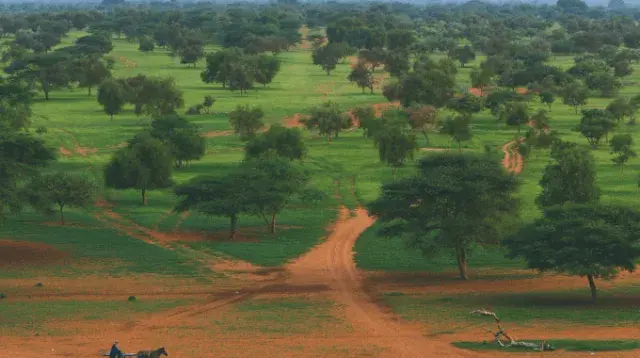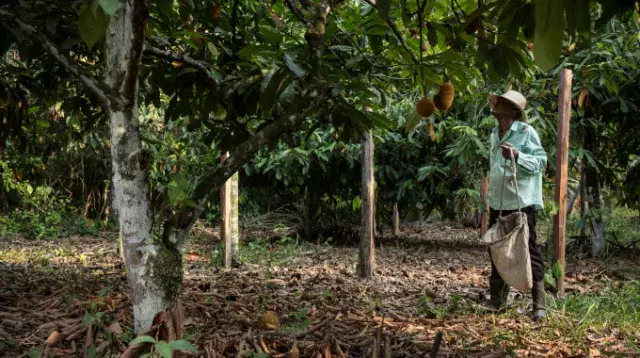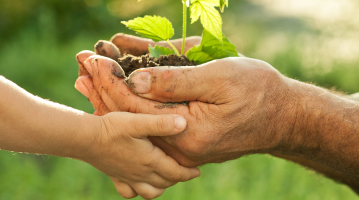Causes and consequences of deforestation
Trees and forests support entire ecosystems. They are habitats for many species, invaluable resources for life on Earth, and are the first line of defence against increasingly dramatic climate events.
Deforestation and land clearing represent direct pressures on the soil, increasing the risks of erosion and desertification and, in turn, leaving us more vulnerable to climate change and disease.
Causes of deforestation
25 million hectares of forest disappear each year, the equivalent of the entire surface area of Greece*. But trees and forests ensure the essential functions of life on Earth, underground and even in the oceans. They’re home to 80% of amphibians, 75% of birds and 65% of mammals. They store 662 billion tons of carbon, or half of the planet’s stock.
But the role of trees and forests goes far beyond “simply” combating climate change. They provide food and medicines, help to fertilise the soil and ensure that groundwater is replenished. Cutting down trees for firewood, agriculture or paper production represents a market worth almost $600 billion annually. But if trees and forests are so important to us, who is responsible for their loss?
– Agriculture: responsible for 80% of the world’s deforestation, farmers clear land to make way for ever more intensive crops or pastures that have no thought for biodiversity. Whether it’s soya in Brazil, palm oil in Indonesia or rubber trees in Cambodia, the world’s forests are disappearing by the hundreds of hectares a day to make way for gigantic monocultures that supply the entire world, directly or indirectly. Soya, for example, is mainly grown to feed cattle, while palm oil is still widely used in many industrial food products.
– Urbanisation: hydroelectric dams, transport networks, communications infrastructure, residential, commercial or industrial developments – there are many reasons people fell entire swathes of land.
– The wood market: whether used in construction, heating or paper production, wood is a key resource. According to the FAO, 4 billion cubic metres of wood is harvested worldwide every year, but only 12% of the world’s wood-producing forests are certified as being sustainably managed. The global illegal timber market is estimated to be worth between $50-150 billion, a phenomenon that should concern us all since, according to the WWF, 23% of forest products imported into Europe were presumed to be of illegal origin in 2010. France was the sixth worst European country in terms of the volume of illegal timber or timber products being imported, while Germany was fourth and the UK was third.
*Global Forest Watch, FAO. 2022. In Brief to The State of the World’s Forests 2022
Consequences of deforestation
Destruction of natural habitats
Trees and forests are the lifeblood of almost 80% of species on land. They provide habitats, food and protection against predators and the climate. They’re extremely rich ecosystems with precious interdependencies. And they don’t just support animal or plant species. In fact, many indigenous human populations depend on the forest to survive, whether it’s their direct habitat or their main source of subsistence.
Worsening natural disasters and climate change
Tree roots and the forest canopy stabilise the soil and provide essential resistance in the event of a major weather event. In the absence of trees, nothing holds the earth together, and the resulting landslides, mudslides, avalanches and flash floods can be disastrous. Trees also provide protection from the wind and help mitigate the effects of cyclones or severe storms. This is particularly apparent with mangroves in coastal environments.
Trees play a crucial role in the water cycle and in regulating temperatures. Not only do they help capture rainwater to replenish the water table, but they also play a part in condensation, ensuring that humidity is well distributed. Without trees, these cycles are massively disrupted and droughts are worse.
Together with the oceans, trees are the most important carbon sinks we have. By capturing CO2 through photosynthesis, they help slow the effects of climate change. Without trees and forests, it will be impossible to keep the rise in global temperatures below 1.5°C by the end of the century, which will have disastrous consequences for all forms of life, especially our own.
Increased exposure to disease
For a long time, the forest was the first line of defence against humanity’s massive incursions into the natural world. With deforestation, encounters between species are becoming more and more frequent, and that’s not necessarily a good thing. Pushed out of their natural habitats, these wild animals and their various pathogens come into contact with humans and domesticated species. The result: zoonoses, diseases caused by pathogens that have “jumped” from an animal to humans. The WHO estimates they’re now responsible for 60% of all diseases, and cause the biggest epidemics.
Soil depletion
The absence of trees in an area that once had many is what leaves the soil exposed to the elements, particularly rain. It doesn’t have to be torrential, but all the nutrients in the soil are simply washed away. As a result, the soil is depleted of the precious components that allow it to nourish plants and support plant biodiversity. This makes it more vulnerable, particularly to drought, which the presence of plants helps to stem. In cultivated areas, trees also help protect crops by “cushioning” rainwater before it hits the ground.

The Great Green Wall: trees against desertification
In the Sahel region of Africa, the desert sands are advancing as deforestation creeps ever closer, burying the hopes of populations forced to flee their ancestral lands to escape unbearable conditions. The challenge here is vast – recreating a brand-new forest and extending it, running like a great green corridor from Dakar to Djibouti, over 7,000km of vegetation to curb the advancing desert. 11 African nations came together in 2004 to create the Pan-African Agency of the Great Green Wall. Klorane Botanical Foundation has been supporting their efforts by offering our assistance in Senegal. More than 100,000 desert date palms have already been planted and over 45,000 hectares of desert have been greened. In partnership with the CNRS and its Observatoire Hommes Milieux (OHM), we’re also funding doctoral theses on the desert date palm and its impact on people, the environment and health, alongside an annual university summer programme.

Fighting deforestation in the Amazon
Klorane Botanical Foundation works with local NGO Instituto Beraca in the Brazilian Amazon to combat deforestation by teaching local populations – particularly the Bela Aurora community – new planting methods. 3,000 cupuaçu plants and other species have been planted to help reforest over 11 hectares of land damaged by deforestation, livestock farming and monocultures.

How to preserve biodiversity?
Preserving biodiversity might seem like a gargantuan task, but we can all do our bit.

Human impacts on biodiversity
Find out more about the threats to biodiversity and how to preserve it
